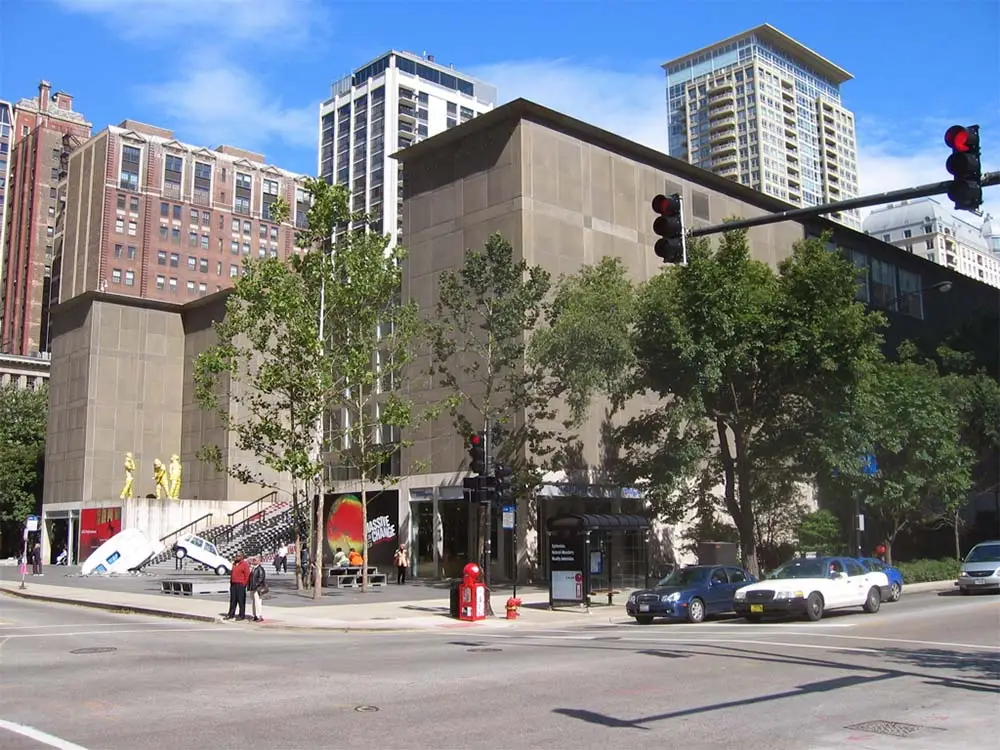Museum of Contemporary Art
Chicago Building ID: 165606

Attribution:
Source
Building Info
- Square Footage
- 233,286 sqftHigher than 72% of all buildings1.9x median124,364 sqft1/3 median Museum620,851 sqft
- Built
- 1996
- Primary Property Type
- Museum
- Building Count
- 2
- Community Area
- Near North Side
- Ward
- 2
-
Chicago Energy Rating
- 1.0 / 4
- Owner
Warning - Data Discrepancies Detected
We detected some issues with this building's data, so these grades may not be reflective of the building's true performance.
2023 Report Card
Debug Full Grade Data
- AvgPercentileLetterGrade: C
- AvgPercentileGrade: 48.7058780422268
- GHGIntensityLetterGrade: F
- GHGIntensityPercentileGrade: 10.186625194401245
- EnergyMixLetterGrade: A
- EnergyMixWeightedPctSum: 58.76180061312483
- EnergyMixPercentileGrade: 84.03141361256544
- SubmittedRecordsLetterGrade: A
- MissingRecordsCount: 0.0
- SubmittedRecordsPercentileGrade: 100.0
Emissions & Energy Information for 2023
- Greenhouse Gas Intensity F
- 10.5 kg CO2e / sqftHigher than 90% of all buildings1.7x median6.2 kg CO2e / sqft1.0x median Museum10.3 kg CO2e / sqft
- Total Greenhouse Gas Emissions
- 2,443 tons CO2eHigher than 84% of all buildings2.9x median841.4 tons CO2e0.6x median Museum4,398.8 tons CO2e
Years Reported
9/9
A

2015
2016
2017
2018
2019
2020
2021
2022
2023
Energy Breakdown for Museum of Contemporary Art
- Fossil Gas Use (aka Natural Gas)
- 9,675,700 kBtuEst. Gas Bill: $115,000 for 2023**Higher than 72% of all buildings1.8x median5,517,828 kBtu0.6x median Museum16,295,149.4 kBtu
- Electricity Use
- 13,787,254 kBtuEst. Electric Bill: $578,000 for 2023**Higher than 87% of all buildings3.9x median3,580,332.6 kBtu0.5x median Museum26,105,774.3 kBtu
Energy Mix A
Total Energy Use: 23,462,955 kBTU
Scan To Learn More
https://electrifychicago.net/building/museum-of-contemporary-art/
View Extra Technical & Historic Info
- Source Energy Usage Intensity
- Not Reported
This data was not reported for this building this year, which likely means a value of zero for this field.
- Site Energy Usage Intensity
- Not Reported
This data was not reported for this building this year, which likely means a value of zero for this field.
Full Historical Data Table for Museum of Contemporary Art
| Year |
Overall Grade |
Emissions Intensity Sub-Grade |
Energy Mix Sub-Grade |
Reporting Mix Sub-Grade | GHG Intensity kg CO2e / sqft | GHG Emissions metric tons CO2e | Energy Mix | Electricity Use kBTU | Fossil Gas Use kBTU | Source EUI kBTU / sqft | Floor Area sqft |
Chicago Energy Rating |
|---|---|---|---|---|---|---|---|---|---|---|---|---|
| 2015 | C | D | C | A | 14 | 4,201 | 46%Electricity 54%Fossil Gas 0%Other | 15,922,586 | 18,860,854 | 232.7 | 300,000 | - |
| 2016 | C | F | B | A | 12.6 | 3,781 | 59%Electricity 41%Fossil Gas 0%Other | 17,038,655 | 12,067,493 | 220.6 | 300,000 | - |
| 2017 | C | F | B | A | 12.1 | 3,627 | 61%Electricity 39%Fossil Gas 0%Other | 16,621,476 | 10,435,724 | 210.5 | 300,000 | - |
| 2018 | C | D | A | A | 10.6 | 3,168 | 69%Electricity 31%Fossil Gas 0%Other | 16,631,412 | 7,560,376 | 181.7 | 300,000 | 3.0 |
| 2019 | C | F | A | A | 60.5 | 18,158 | 90%Electricity 10%Fossil Gas 0%Other | 105,295,787 | 12,077,079 | 1025 | 300,000 | 1.0 |
| 2020 | C | D | B | A | 7.6 | 2,265 | 55%Electricity 45%Fossil Gas 0%Other | 11,376,797 | 9,214,723 | 138.4 | 316,080 | 3.0 |
| 2021 | B | A | B | A | 4.7 | 1,406 | 40%Electricity 60%Fossil Gas 0%Other | 6,300,466 | 9,531,951 | 92.2 | 316,080 | 4.0 |
| 2022 | B | B | B | A | 4.9 | 1,477 | 45%Electricity 55%Fossil Gas 0%Other | 7,507,292 | 9,191,930 | 102.2 | 316,080 | 4.0 |
| 2023 | C | F | A | A | 10.5 | 2,443 | 59%Electricity 41%Fossil Gas 0%Other | 13,787,255 | 9,675,700 | 209 | 233,286 | 1.0 |
* Note on Rankings: Rankings and medians are among included buildings, which are those who reported under the Chicago Energy Benchmarking Ordinance for the year 2023, which only applies to buildings over 50,000 square feet.
** Note on Bill Estimates:
Estimates for gas and electric bills are based on average electric and
gas retail prices for Chicago in 2021 and
are rounded. We expect large buildings would negotiate lower rates with
utilities, but these estimates serve as an upper bound of cost and help
understand the volume of energy a building is used by comparing it to
your own energy bills! See our
Chicago Gas & Electric Costs Source
for the original statistics.
Data Source:
Chicago Energy Benchmarking Data